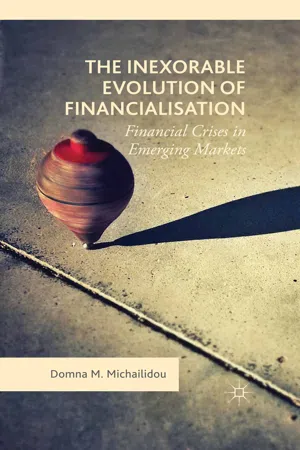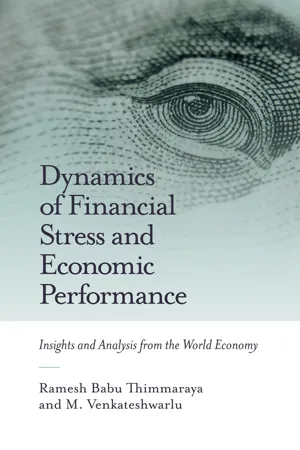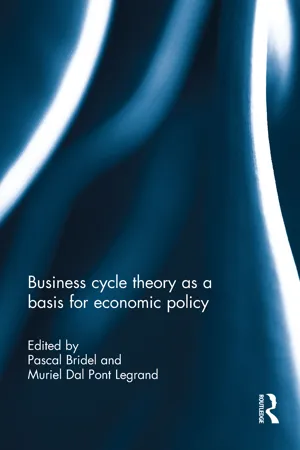Economics
Dynamics of Financial Crises
The dynamics of financial crises refer to the patterns and processes that characterize the development and impact of such crises on the economy. This includes the build-up of vulnerabilities, triggers that lead to crisis onset, and the subsequent spread of financial distress. Understanding these dynamics is crucial for policymakers and economists in devising effective measures to prevent and mitigate the impact of financial crises.
Written by Perlego with AI-assistance
Related key terms
5 Key excerpts on "Dynamics of Financial Crises"
- eBook - ePub
- Indranarain Ramlall(Author)
- 2018(Publication Date)
- Emerald Publishing Limited(Publisher)
Chapter 6
Financial Crises
6.1. Key Features of A Crisis
- Economic and financial crises tend to be recurrent in nature. This implies that the same phenomena are at work to constitute the genesis of a crisis.
- Nearly, all crises exhibit three common elements. First, there is distrust in the financial system or lack of confidence in the financial system. Second, there are spillover or contagion effects such as in the case of Allen and Gale (2009) who base themselves on the contagious transmission of bank difficulties. Third, there are network effects based on endogenous interactions among different financial institutions.
- A crisis is usually financial in first stage to then entangle the real economy in the second stage. This can be corroborated by the evolution of the global financial crisis in 2007 into an economic crisis and thereafter into a debt crisis.
- Crisis often occurs because market players assume that EMH (all relevant information is automatically reflected in the price) holds while in practice it is hard to see that assets are properly priced – a clear instance of this appears during the US subprime crisis.
- Humans have a strong tendency to herd so that deleveraging of assets often witnesses a highly painful adjustment in the financial system, all geared towards an unending downward spiral in asset prices.
- Crises are often caused by two events, a euphoria phase and a de-illusion stage. Under the euphoria stage, there are strong incentives to push forward asset prices while in the de-illusion stage, investors began to realise of over-valued assets which then lead to massive sell-offs and drastic asset price declines. The leverage cycle (Geneakopolous, 2009) contributes to higher asset prices. When the de-illusion stage manifested in the case of the US subprime crisis, it led to negative equity holdings by borrowers who had no choice but to deliberately default on their home loans.
- Political forces can also contribute to crises. For instance, in the case of the US subprime crisis, there were strong political incentives to make each household own his home.
- eBook - ePub
The Inexorable Evolution of Financialisation
Financial Crises in Emerging Markets
- Domna M. Michailidou(Author)
- 2016(Publication Date)
- Palgrave Macmillan(Publisher)
The on-going world recession and continuously deepening Eurozone debt crisis bring to the forefront of discussion the need for economic policy designed to tackle financial instability. The question thus addressed in this book is essential for the identification of the nature and volume of intervention needed in financial markets. The hazard of financial instability has become central in development economics, and increasingly there has been discussion on the nature of required policy design and intervention. Creating a framework inimical to systemic financial crises has been historically a major concern of policymakers, but now more than ever this development is in need of urgent realisation. Understanding the mechanisms behind the occurrence of systemic financial crises and averting their incidence could be an important first step for policy towards this direction. It is exactly to this field that this research attempts to make a contribution.To understand how capital flows can induce volatility in financial markets, and consequently to the whole of the economy, the book investigates a series of specific and inter-connected developments which, given the economies’ macroeconomic fundamentals, contributed to the crises that occurred. These are the causes of the abrupt increase in the stocks and flows of financial capital, the reasons behind their direction towards new outlets – specifically emerging economies – and the policies pursued in the recipient countries to deal with the inflows and the type and maturity-horizons assigned to the inflows. With regard to the factors causing the abrupt jumps in the generation and circulation of flows, we identify external and internal factors contributing to the changes and shaping the levels of financial capital in the emerging world. Following the work of distinguished scholars, a distinction is drawn between supply-push and demand-pull factors related to the jumps of capital flows (see Palma, 2003a, 2011a). The first are specific to the generation of liquidity through deregulation, financial engineering and lower profit opportunities manifested in the lower returns of US Treasury bonds and the overall slowdown of economic growth in the Western markets. The second are specific to changes applied to the overall economic policies and financial markets of emerging economies. This is delivered to set the background against the attraction of all capital inflows which when combined with an analysis of their type and maturity allows us to shape conclusions on the real causes of the crises. - eBook - ePub
The Bank Credit Analysis Handbook
A Guide for Analysts, Bankers and Investors
- Jonathan Golin, Philippe Delhaise(Authors)
- 2013(Publication Date)
- Wiley(Publisher)
- Banks see sources of funding become costly or dry up entirely. Liquidity is thereby weakened, making the funding of new loans problematic, while margins are squeezed.
- Existing asset quality problems reveal themselves as lending declines. Bad loans turn sour and become a larger percentage of a contracting loan book.
- Profits take a hit from new loan-loss provisioning requirements generated as a result of the souring loans. As these requirements become increasingly difficult to meet from dwindling earnings, bank capital is impaired.
Once the crisis begins to affect the real economy, as it almost inevitably must, a vicious cycle is initiated making the restoration of confidence and bank capital, earnings, asset quality, and liquidity increasingly difficult.54Currency or Financial Crises and Their Relationship to Banking Crises
[A financial crisis ]is a situation where it becomes publicly known that the central bank has run out (or is about to run out) of reserves and could shortly become unable to service the country’s foreign-currency debt obligations.55—Alexandre Lamfalussy56Distinct from a banking crisis, but often associated with, or even also defined as a financial crisis, is a currency crisis, which describes the precipitous decline in country’s domestic currency relative to a reserve currency, such as the U.S. dollar or the euro. A currency crisis can also be said to occur when a speculative attack intended to force a devaluation costs the affected country’s central bank a substantial sum to avert. The currency crisis often turns into a financial crisis when the country is no longer in a position to defend its currency. The essence of a currency crisis is either a large devaluation of a country’s currency, or the threat of such a devaluation that results in substantial expenditure of funds by the central bank. As is a banking crisis, a currency crisis is invariably accompanied by a rapid shift in market sentiment. The manifestation of a full-blown currency crisis will almost inevitably be followed by a destruction of wealth that puts the brakes on the real economy, and it may trigger a banking crisis if one is not already in progress.57 - Ramesh Babu Thimmaraya, M. Venkateshwarlu(Authors)
- 2018(Publication Date)
- Emerald Publishing Limited(Publisher)
Chapter 4
Dynamics of Financial and Economic Systems
4.1. Introduction
The analysis of financial market stress index and financial market credit leverage has been discussed in the previous chapters. The present chapter discusses multivariate interaction between the financial system (virtual economy) and economic system (real economy). However, it is very important to understand whether a meaningful statistical/mathematical and/or economic relationship can be established between the financial and economic systems.Most data in the market about the financial and economic systems are probabilistic (inherent randomness in it) in nature, which implies that finding a closed form mathematical relationship can be quite complex. To understand the relationship between these random variables, analysts in banks and other financial institutes use some sort of statistical modeling (economists call it econometrics). Most of these models are based on historical data (Regulatory & Economic Risk models of bank's across the world are terribly biased towards historical data, because, evolution of the system dynamics during shock penetrations are mostly less predictable by the time dimension. However, regulating the bank’s leverage dynamics till the bank models mature to a semi-standard form at-least across the country is one optimal path); given the complexity and inherent dynamics in the financial and economic systems, it is very difficult to develop robust and precise models for forecasting the future1 .Let’s discuss it with an example: to understand the modeling mysticism better, assume a bank analyst is trying to find a statistical relationship between GDP growth and inflation. The analyst will be lucky if the variables have a simple linear relationship between them in the long run. If he cannot establish this, then he will look into more advanced methods like threshold-based models or bilinear models and finally to a complex black box modeling. These advanced methods need more parameters to be calibrated; the more the parameters, the less the degrees of freedom available for the system. Increasing the number of parameters in the system will aggravate the model risk further via more of calibrations and more frequent calibrations.- Pascal Bridel, Muriel Dalpont(Authors)
- 2017(Publication Date)
- Routledge(Publisher)
Economics of the crisis and the crisis of economics Axel Leijonhufvud1. Balance sheet troubles
This is not an ordinary recession. The problems unleashed by the financial crisis are far more serious and intractable than that.The United States and the Eurozone countries are in the midst of a balance sheet recession. The concept is due to Richard Koo1 who used the term to summarise his diagnosis of Japan’s economic troubles in the wake of its 1992–1993 crisis. A balance sheet recession is fundamentally different from the garden variety and the usual countercyclical policies are not adequate to cope with it. The questions to be discussed below all pertain to the extraordinary nature of balance sheet recessions in general and, of course, the present one in particular: What makes them different from ordinary cyclical recessions? How do they come about? What makes them peculiarly intractable? What policies are effective or less effective in dealing with them?Apart from these substantive questions, there is one further question worth considering: What kind of economic theory helps us understand these matters better and what kinds do not?2. Stability and instability
How did we end up in our present unpredicted predicament? A short answer would be: by not being alert to the symptoms of instability. Almost all bankers, regulators, policy-makers and (of course) economists disregarded the possibility of serious systemic instability. But the widespread assumption that a system of “free markets” is stable needs re-examination.2.1 Markets for produced goods
The beginning student’s first introduction to economics tends to be the supply and demand model for a produced good. Two negative feedback loops are supposed to guarantee that the equilibrium is reached (ceteris paribus). If supply exceeds demand, price will rise so as to reduce the discrepancy in quantities. If marginal cost exceeds the demand price, output will decline so as to decrease the discrepancy in values. Both feedbacks reduce the deviation
Learn about this page
Index pages curate the most relevant extracts from our library of academic textbooks. They’ve been created using an in-house natural language model (NLM), each adding context and meaning to key research topics.




